Assessment of Ecotourism Environmental Carrying Capacity in the Qilian Mountains, Northwest China
Abstract
1. Introduction
2. Materials and Methods
2.1. Overview of the Study Area
2.2. Data Sources
2.2.1. Meteorological Data
2.2.2. NDVI Data
2.2.3. Land Use Data
2.2.4. Socio-Economic Data
2.3. Methods
2.3.1. Construction of Evaluation Indicator System for EECC
2.3.2. Calculation of Evaluation Indicators
- (1)
- Vegetation coverage
- (2)
- Biological richness index
- (3)
- Water yield
- (4)
- Landscape diversity
2.3.3. Calculation of Indicator Weights
- (1)
- Standardization of positive and negative indicators
- (2)
- Information entropy
- (3)
- Weights
2.3.4. Calculation of EECC Based on the Comprehensive Indicator Method
2.3.5. Classification of EECC Levels
3. Results
3.1. Variation Characteristics of Evaluation Indicators
3.1.1. Indicators of Natural Ecological Environment Support
3.1.2. Indicators of Socio-Economic Pressure
3.1.3. Indicators of Tourism Activity Pressure
3.2. Variation Characteristics of Different Subsystems
3.3. Variation Characteristics of EECC
4. Discussion
4.1. Changes in Different Subsystems and Links between Them
4.2. Causes of Changes in EECC
4.3. Uncertainties and Future Work
5. Conclusions
Author Contributions
Funding
Institutional Review Board Statement
Informed Consent Statement
Data Availability Statement
Conflicts of Interest
References
- Asadpourian, Z.; Rahimian, M.; Gholamrezai, S. SWOT-AHP-TOWS analysis for sustainable ecotourism development in the best area in Lorestan Province, Iran. Soc. Indic. Res. 2020, 152, 289–315. [Google Scholar] [CrossRef]
- He, H.; Shen, L.; Wong, S.W.; Cheng, G.; Shu, T. A “load-carrier” perspective approach for assessing tourism resource carrying capacity. Tour. Manag. 2023, 94, 104651. [Google Scholar] [CrossRef]
- Grimes, S.; Bouchair, A.; Tebbouche, H. Sustainability of the Expansion Areas for Coastal Touristic Sites “EACTS” Such as the case of El-Aouana in Algeria: Indicators for considering biodiversity. Energy Procedia 2017, 119, 170–181. [Google Scholar] [CrossRef]
- Streimikiene, D.; Svagzdiene, B.; Jasinskas, E.; Simanavicius, A. Sustainable tourism development and competitiveness: The systematic literature review. Sustain. Dev. 2021, 29, 259–271. [Google Scholar] [CrossRef]
- Stronza, A.L.; Hunt, C.A.; Fitzgerald, L.A. Ecotourism for conservation? Annu. Rev. Environ. Resour. 2019, 44, 229–253. [Google Scholar] [CrossRef]
- Singh, T.; Slotkin, M.H.; Vamosi, A.R. Attitude towards ecotourism and environmental advocacy: Profiling the dimensions of sustainability. J. Vacat. Mark. 2007, 13, 119–134. [Google Scholar] [CrossRef]
- Wackernagel, M.; Rees, W. Our Ecological Footprint: Reducing Human Impact on the Earth; New Society Publishers: Gabriola, BC, Canada, 1998; Volume 9. [Google Scholar]
- Salemi, M.; Jozi, S.A.; Malmasi, S.; Rezaian, S. A new model of ecological carrying capacity for developing ecotourism in the protected area of the north karkheh, Iran. J. Indian Soc. Remote Sens. 2019, 47, 1937–1947. [Google Scholar] [CrossRef]
- Li, J.; Weng, G.; Pan, Y.; Li, C.; Wang, N. A scientometric review of tourism carrying capacity research: Cooperation, hotspots, and prospect. J. Clean. Prod. 2021, 325, 129278. [Google Scholar] [CrossRef]
- Li, Y.H.; Xiang, B. Research Progress in the Ecotourism Environmental Carrying Capacity. Adv. Mater. Res. 2014, 869, 781–785. [Google Scholar] [CrossRef]
- Lu, J.; Chen, H. Dynamic Evaluation and Forecasting Analysis of Touristic Ecological Carrying Capacity of Forest Parks in China. Forests 2023, 15, 38. [Google Scholar] [CrossRef]
- Wulandari, A.; Maryono, M.; Setyawan, A. Carrying capacity for ecotourism development in Tahura KGPAA Mangkunagoro I. In E3S Web of Conferences; EDP Sciences: Les Ulis, France, 2018; Volume 73, p. 02007. [Google Scholar]
- Yu, K.; Gao, H. Sustainable development, eco-tourism carrying capacity and fuzzy algorithm-a study on Kanas in Belt and Road. Sci. Rep. 2023, 13, 16789. [Google Scholar] [CrossRef] [PubMed]
- Shi, L.; Zhao, H.; Li, Y.; Ma, H.; Yang, S.; Wang, H. Evaluation of Shangri-La County’s tourism resources and ecotourism carrying capacity. Int. J. Sustain. Dev. World Ecol. 2015, 22, 103–109. [Google Scholar] [CrossRef]
- Chen, H.S.; Chen, C.Y.; Chang, C.T.; Hsieh, T. The construction and application of a carrying capacity evaluation model in a national park. Stoch. Environ. Res. Risk Assess. 2014, 28, 1333–1341. [Google Scholar] [CrossRef]
- Leka, A.; Lagarias, A.; Panagiotopoulou, M.; Stratigea, A. Development of a Tourism Carrying Capacity Index (TCCI) for sustainable management of coastal areas in Mediterranean islands–Case study Naxos, Greece. Ocean Coast. Manag. 2022, 216, 105978. [Google Scholar] [CrossRef]
- Xiang, B.H.; Zeng, Y.X. Ecotourism construction and operating mechanism in the Sanjiangyuan National Park System Pilot Area, China. Resour. Sci. 2017, 39, 50–60. (In Chinese) [Google Scholar]
- Hu, G. Study on the temporal and spatial differences of ecotourism environmental carrying capacity in Shanxi Province. For. Econ. 2019, 41, 110–115. (In Chinese) [Google Scholar]
- Huang, B.R.; Ma, Y.H.; Huang, K.; Su, L.Y.; Zhang, C.L.; Cheng, D.W.; Wang, Y. Strategic Approach on Promoting Reform of China’s Natural Protected Areas System with National Parks as Backbone. Bull. Chin. Acad. Sci. 2018, 33, 1342–1351. (In Chinese) [Google Scholar]
- Ma, L.; Zhu, Z.; Li, S.; Li, J. Analysis of spatial and temporal changes in human interference in important ecological function areas in China: The Gansu section of Qilian Mountain National Park as an example. Environ. Monit. Assess. 2023, 195, 1029. [Google Scholar] [CrossRef]
- Ren, B.; Park, K.; Shrestha, A.; Yang, J.; McHale, M.; Bai, W.; Wang, G. Impact of Human Disturbances on the Spatial Heterogeneity of Landscape Fragmentation in Qilian Mountain National Park, China. Land 2022, 11, 2087. [Google Scholar] [CrossRef]
- Duan, Q.; Luo, L.; Zhao, W.; Zhuang, Y.; Liu, F. Mapping and evaluating human pressure changes in the Qilian mountains. Remote Sens. 2021, 13, 2400. [Google Scholar] [CrossRef]
- Holben, B.N. Characteristics of maximum-value composite images from temporal AVHRR data. Int. J. Remote Sens. 1986, 7, 1417–1434. [Google Scholar] [CrossRef]
- Wang, J.; Huang, X.; Gong, Z.; Cao, K. Dynamic assessment of tourism carrying capacity and its impacts on tourism economic growth in urban tourism destinations in China. J. Destin. Mark. Manage. 2020, 15, 100383. [Google Scholar] [CrossRef]
- Carlson, T.N.; Ripley, D.A. On the relation between NDVI, fractional vegetation cover, and leaf area index. Remote Sens. Environ. 1997, 62, 241–252. [Google Scholar] [CrossRef]
- Tallis, H.T.; Ricketts, T.; Guerry, A.D.; Wood, S.A.; Sharp, R.; Nelson, E.; Ennaanay, D.; Wolny, S.; Olwero, N.; Vigerstol, K.; et al. Integrated Valuation of Environmental Services and Tradeoffs (InVEST) 3.1. 0 User’s Guide; Natural Capital Project: Washington, DC, USA, 2014. [Google Scholar]
- Listopad, C.M.; Masters, R.E.; Drake, J.; Weishampel, J.; Branquinho, C. Structural diversity indices based on airborne LiDAR as ecological indicators for managing highly dynamic landscapes. Ecol. Indic. 2015, 57, 268–279. [Google Scholar] [CrossRef]
- Shemshadi, A.; Shirazi, H.; Toreihi, M.; Tarokh, M.J. A fuzzy VIKOR method for supplier selection based on entropy measure for objective weighting. Expert Syst. Appl. 2011, 38, 12160–12167. [Google Scholar] [CrossRef]
- Wu, T.; Sang, S.; Wang, S.; Yang, Y.; Li, M. Remote sensing assessment and spatiotemporal variations analysis of ecological carrying capacity in the Aral Sea Basin. Sci. Total Environ. 2020, 735, 139562. [Google Scholar] [CrossRef] [PubMed]
- Ma, X.; Zhang, H. Land-Use/Land-Cover Change and Ecosystem Service Provision in Qinghai Province, China: From the Perspective of Five Ecological Function Zones. Land 2023, 12, 656. [Google Scholar] [CrossRef]
- Wang, X.; Zhu, J.; Peng, S.; Zheng, T.; Qi, Z.; Hu, J.; Ji, C. Patterns of grassland community composition and structure along an elevational gradient on the Qinghai–Tibet Plateau. J. Plant Ecol. 2022, 15, 808–817. [Google Scholar] [CrossRef]
- Li, Z.X.; Feng, Q.; Li, Z.J.; Wang, X.F.; Gui, J.; Zhang, B.; Li, Y.C.; Deng, X.H.; Jian, X.; Gao, W.D.; et al. Reversing conflict between humans and the environment-The experience in the Qilian Mountains. Renew. Sustain. Energy Rev. 2021, 148, 111333. [Google Scholar] [CrossRef]
- Litman, T. Evaluating Transportation Economic Development Impacts; Victoria Transport Policy Institute: Victoria, BC, Canada, 2017. [Google Scholar]
- Yin, F.; Deng, X.; Jin, Q.; Yuan, Y.; Zhao, C. The impacts of climate change and human activities on grassland productivity in Qinghai Province, China. Front. Earth Sci. 2014, 8, 93–103. [Google Scholar] [CrossRef]
- Ruan, W.; Li, Y.; Zhang, S.; Liu, C.H. Evaluation and drive mechanism of tourism ecological security based on the DPSIR-DEA model. Tour. Manag. 2019, 75, 609–625. [Google Scholar] [CrossRef]
- Zekan, B.; Weismayer, C.; Gunter, U.; Schuh, B.; Sedlacek, S. Regional sustainability and tourism carrying capacities. J. Clean. Prod. 2022, 339, 130624. [Google Scholar] [CrossRef]
- Wang, Y.; Wu, C.; Wang, F.; Sun, Q.; Wang, X.; Guo, S. Comprehensive evaluation and prediction of tourism ecological security in droughty area national parks—A case study of Qilian Mountain of Zhangye section, China. Environ. Sci. Pollut. Res. 2021, 28, 16816–16829. [Google Scholar] [CrossRef]
- Pu, L.; Lu, C.; Yang, X.; Chen, X. Spatio-Temporal Variation of the Ecosystem Service Value in Qilian Mountain National Park (Gansu Area) Based on Land Use. Land 2023, 12, 201. [Google Scholar] [CrossRef]
- Jiang, G.Y.; Zhuo, M.C. Environment carrying capacity of eco-tourism at county levels in the south of the Qinghai-Tibet Plateau. J. Arid Land Resour. Environ. 2014, 28, 202–208. (In Chinese) [Google Scholar]
- Zhi, L.H.; Zhang, Z.; Bai, J.H.; Li, X.W. Research on the carrying capacity of tourism environment in the yellow river delta. Environ. Eng. 2023, 41, 132–140, 163. (In Chinese) [Google Scholar]
- Shan, S.Y.; Xu, H.J.; Qi, X.L.; Chen, T.; Wang, X.D. Evaluation and prediction of ecological carrying capacity in the Qilian Mountain National Park, China. J. Environ. Manag. 2023, 339, 117856. [Google Scholar] [CrossRef] [PubMed]
- Guo, B.; Liu, Y.; Fan, J.; Lu, M.; Zang, W.; Liu, C.; Wang, B.; Huang, X.; Lai, J.; Wu, H. The salinization process and its response to the combined processes of climate change–human activity in the Yellow River Delta between 1984 and 2022. Catena 2023, 231, 107301. [Google Scholar] [CrossRef]
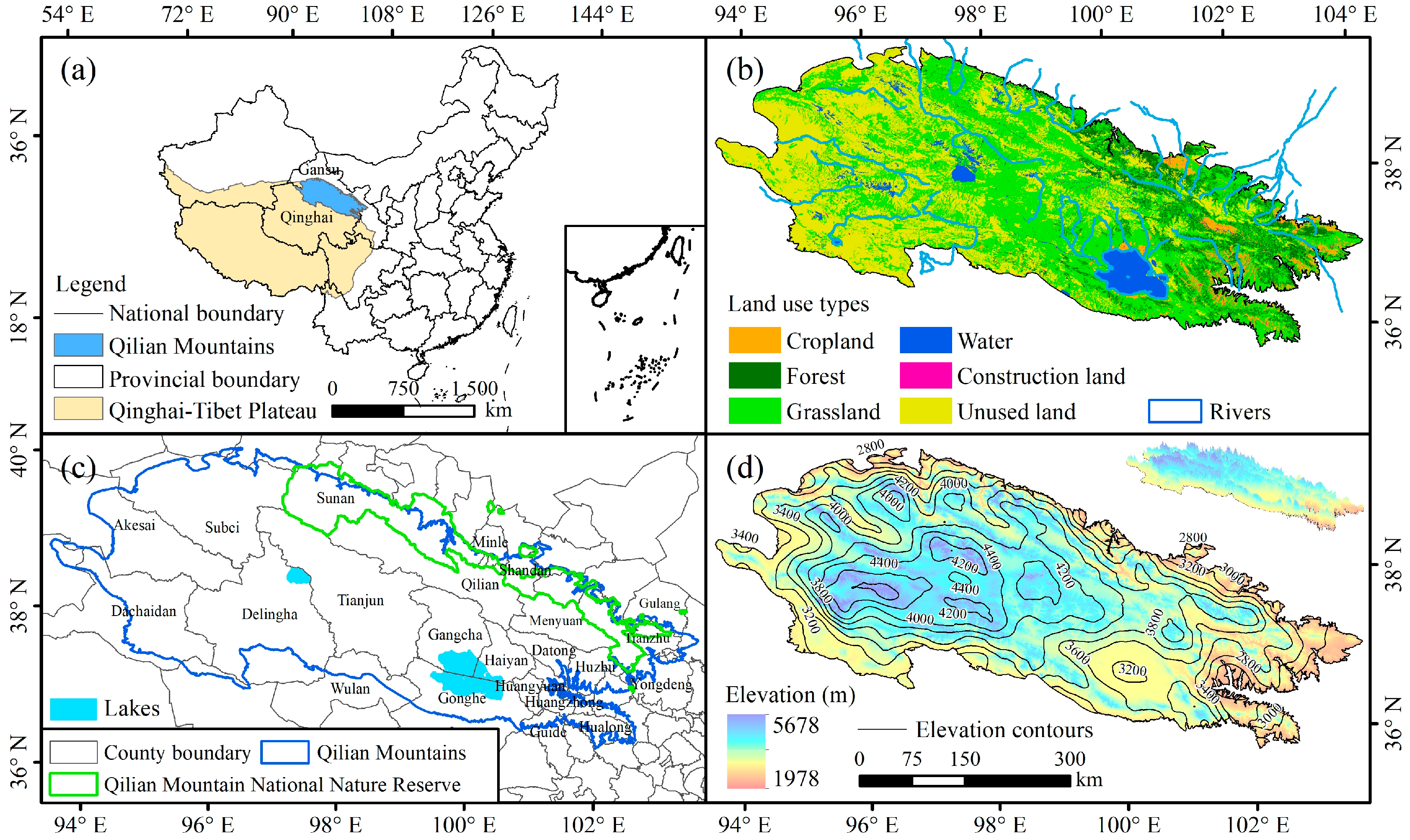
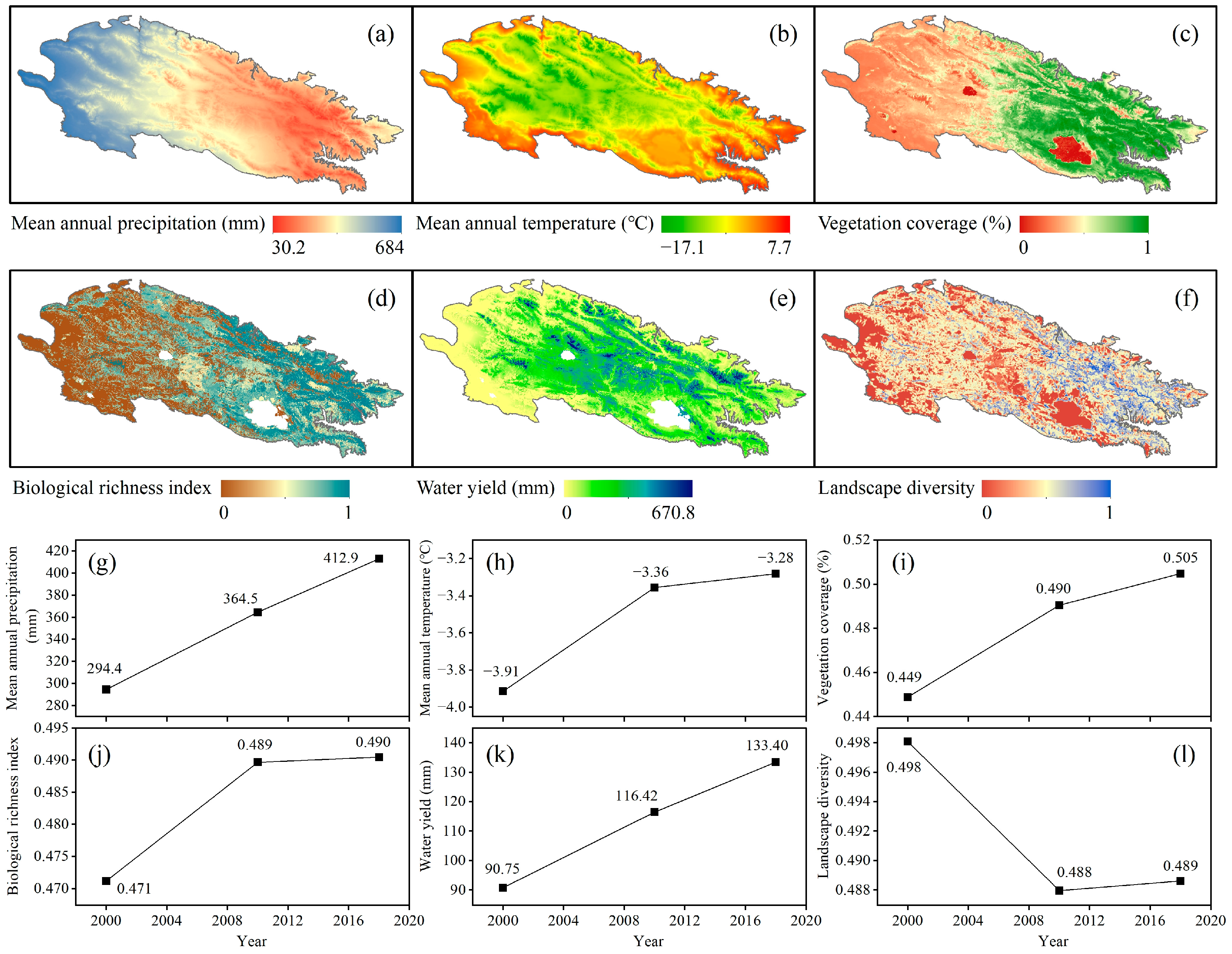
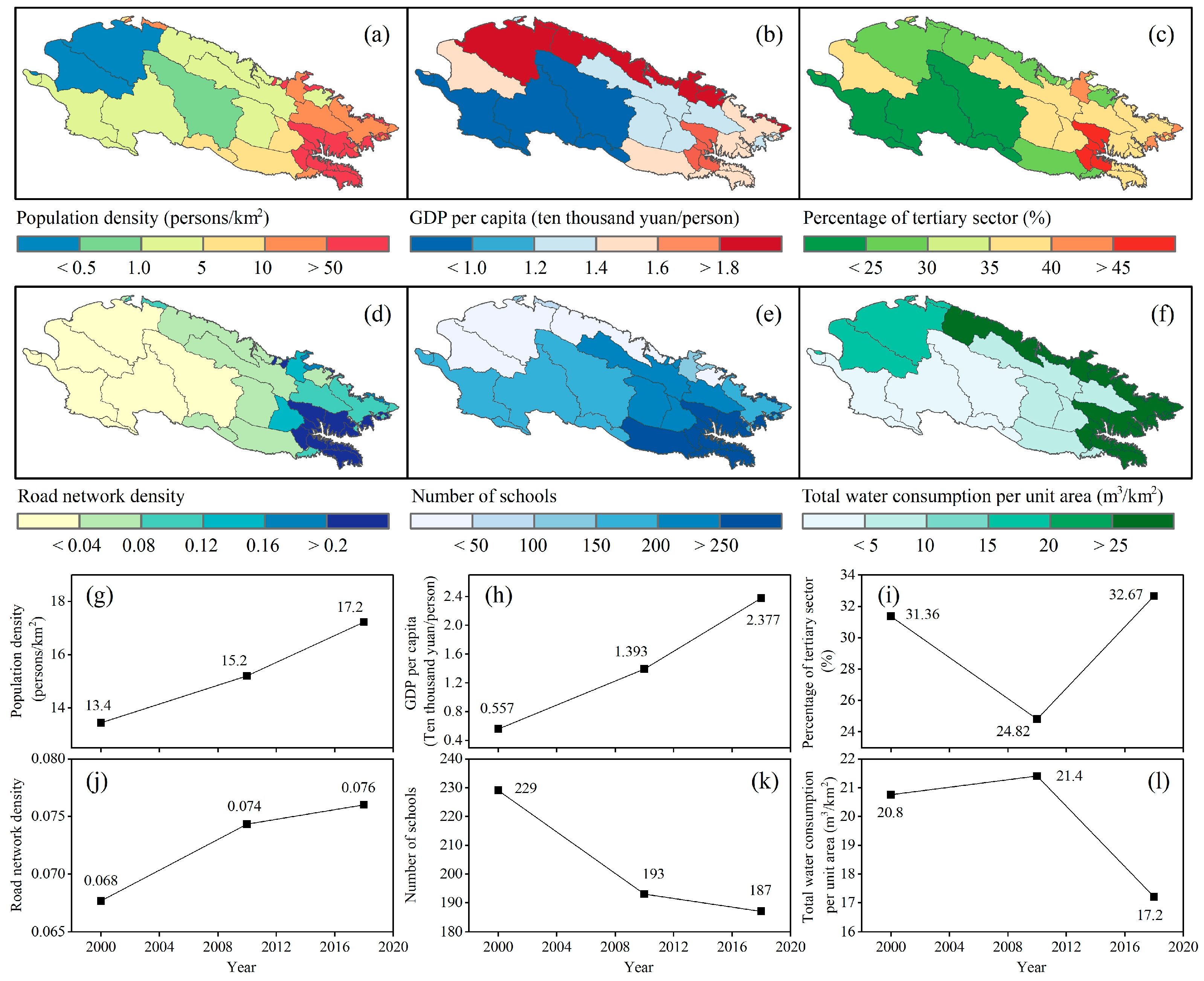
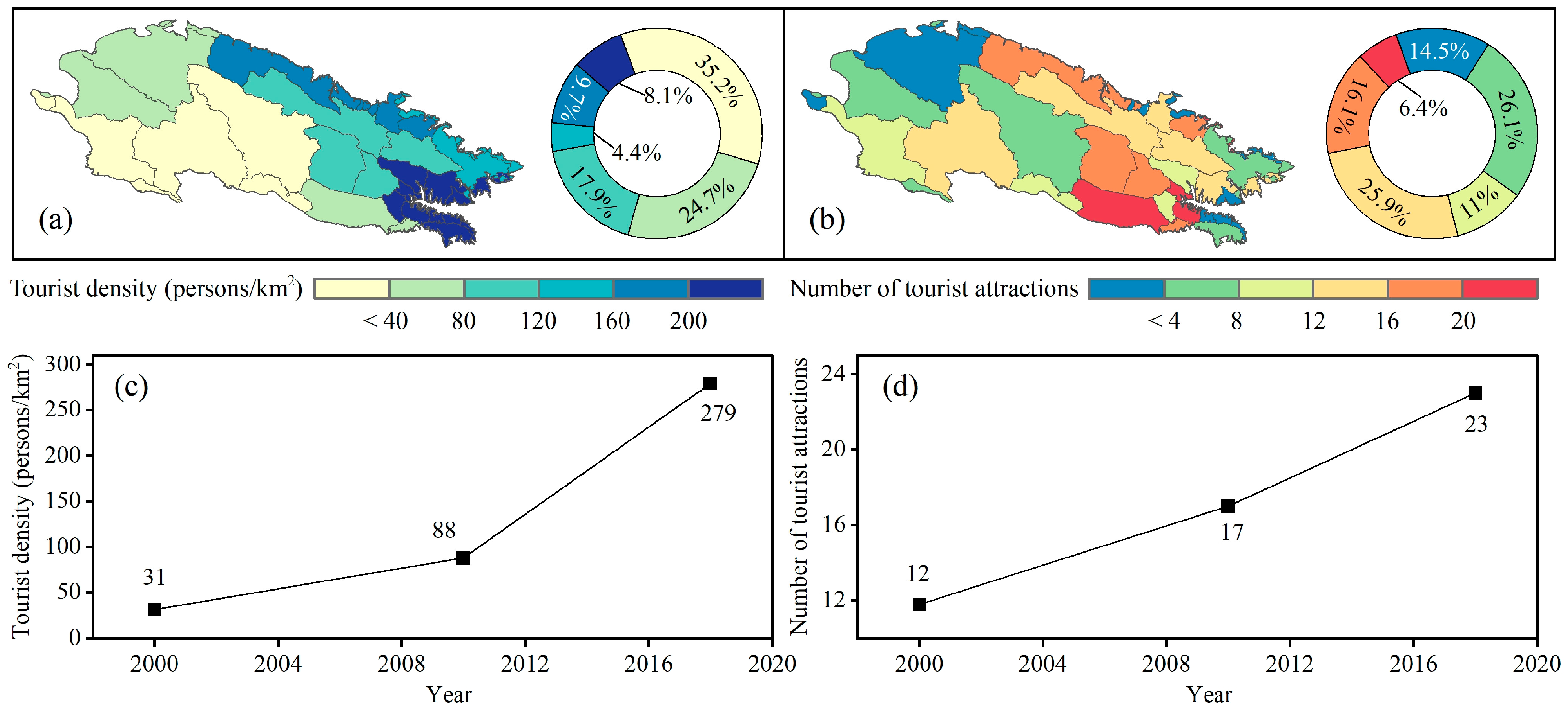

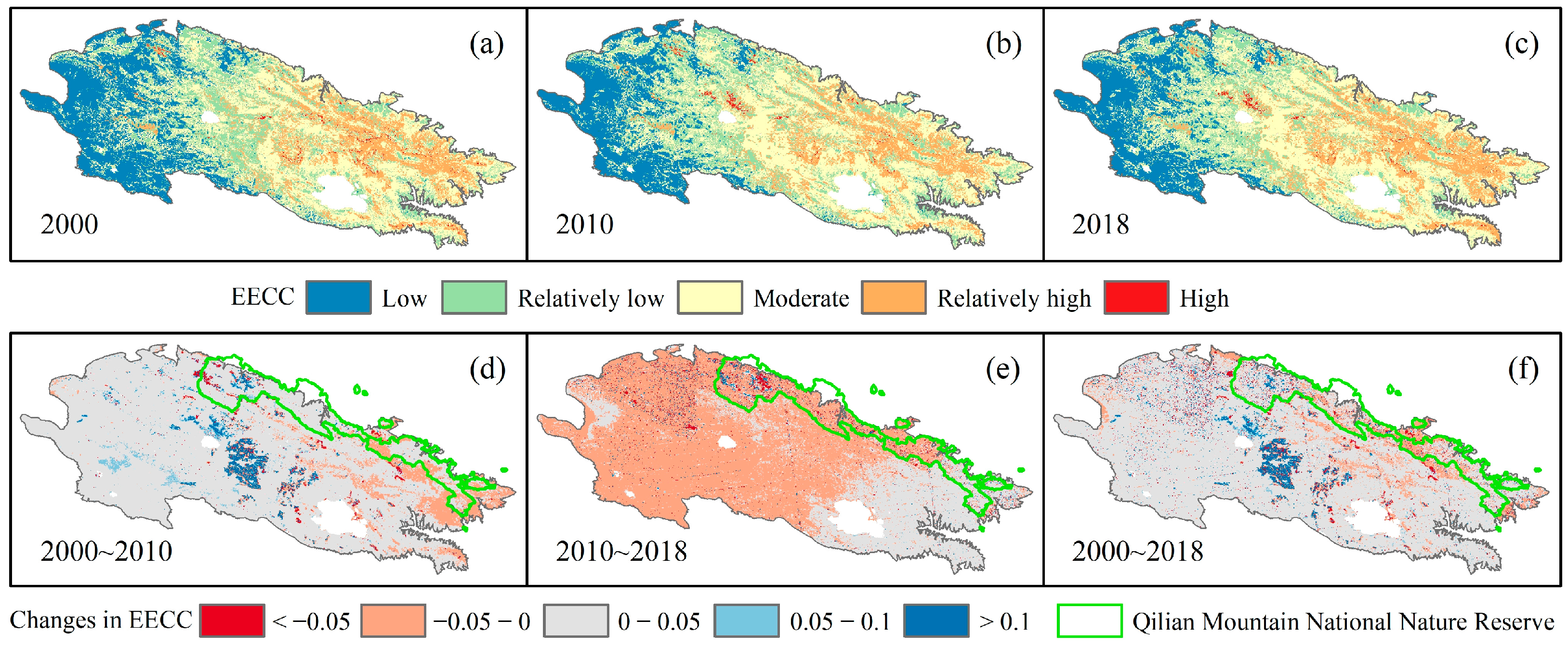
| Objective Layer | Standardized Layer | Indicator Layer | Properties | Weights |
|---|---|---|---|---|
| Ecotourism environmental carrying capacity | Natural ecological environment support | Precipitation | Positive | 0.064 |
| Temperature | Positive | 0.025 | ||
| Vegetation coverage | Positive | 0.056 | ||
| Biological richness index | Positive | 0.250 | ||
| Water yield | Positive | 0.243 | ||
| Landscape diversity | Positive | 0.185 | ||
| Socio-economic pressure | Population density | Negative | 0.0002 | |
| GDP per capita | Negative | 0.006 | ||
| Percentage of tertiary sector | Negative | 0.045 | ||
| Road network density | Negative | 0.0002 | ||
| Number of schools | Negative | 0.032 | ||
| Total water consumption per unit area | Negative | 0.024 | ||
| Tourism activity | Tourist density | Negative | 0.015 | |
| Number of tourist attractions | Negative | 0.052 |
| EECC values | 0–0.2 | 0.2–0.4 | 0.4–0.6 | 0.6–0.8 | 0.8–1.0 |
| EECC levels | Low EECC | Relatively low EECC | Moderate EECC | Relatively high EECC | High EECC |
Disclaimer/Publisher’s Note: The statements, opinions and data contained in all publications are solely those of the individual author(s) and contributor(s) and not of MDPI and/or the editor(s). MDPI and/or the editor(s) disclaim responsibility for any injury to people or property resulting from any ideas, methods, instructions or products referred to in the content. |
© 2024 by the authors. Licensee MDPI, Basel, Switzerland. This article is an open access article distributed under the terms and conditions of the Creative Commons Attribution (CC BY) license (https://creativecommons.org/licenses/by/4.0/).
Share and Cite
Du, Q.; Guan, Q.; Sun, Y.; Wang, Q. Assessment of Ecotourism Environmental Carrying Capacity in the Qilian Mountains, Northwest China. Sustainability 2024, 16, 1873. https://doi.org/10.3390/su16051873
Du Q, Guan Q, Sun Y, Wang Q. Assessment of Ecotourism Environmental Carrying Capacity in the Qilian Mountains, Northwest China. Sustainability. 2024; 16(5):1873. https://doi.org/10.3390/su16051873
Chicago/Turabian StyleDu, Qinqin, Qingyu Guan, Yunfan Sun, and Qingzheng Wang. 2024. "Assessment of Ecotourism Environmental Carrying Capacity in the Qilian Mountains, Northwest China" Sustainability 16, no. 5: 1873. https://doi.org/10.3390/su16051873
APA StyleDu, Q., Guan, Q., Sun, Y., & Wang, Q. (2024). Assessment of Ecotourism Environmental Carrying Capacity in the Qilian Mountains, Northwest China. Sustainability, 16(5), 1873. https://doi.org/10.3390/su16051873





